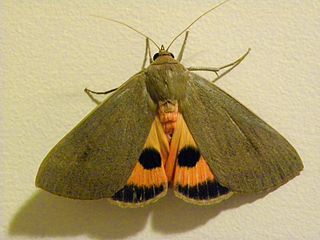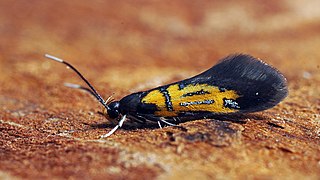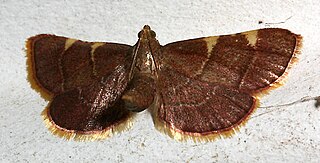
The Pyralidae, commonly called pyralid moths, snout moths or grass moths, are a family of Lepidoptera in the ditrysian superfamily Pyraloidea. In many classifications, the grass moths (Crambidae) are included in the Pyralidae as a subfamily, making the combined group one of the largest families in the Lepidoptera. The latest review by Eugene G. Munroe and Maria Alma Solis retain the Crambidae as a full family of Pyraloidea.

The Pyralini are a tribe of snout moths described by Pierre André Latreille in 1809. They belong to the subfamily Pyralinae, which contains the "typical" snout moths of the Old World and some other regions. The genus list presented here is provisional.

Hypsopygia costalis, the gold triangle or clover hay moth, is a species of moth of the family Pyralidae. It was described by Johan Christian Fabricius in 1775 and is found in Europe. The wingspan is 16–23 mm. The adult moths fly from May to July, depending on the location. The supposed species H. aurotaenialis is included here pending further study.

Pseudatemelia flavifrontella is a species of gelechioid moths.

Aglossa caprealis, the stored grain moth, is a moth species of the family Pyralidae. It is found globally, though its native range is presumably the western Palearctic or nearby regions, as in other Aglossa species.

The rice moth is a moth of the family Pyralidae. This small moth can become a significant pest. Its caterpillars feed on dry plantstuffs such as seeds, including cereals. Other recorded foods are flour and dried fruits.

Hypsopygia is a genus of moths belonging to the family Pyralidae. Though fairly small, they are large among their relatives. It was described by Jacob Hübner in 1825.

Ocrasa is a genus of moths belonging to the family Pyralidae. The genus is mostly treated as a synonym of Hypsopygia. If considered valid, the genus includes many species which were formerly included in Herculia. In addition, the proposed genus Orthopygia, which some authors consider a separate lineage is here merged with Ocrasa. The latter two genera are also mostly merged with Hypsopygia however.

Alabonia is a genus of gelechioid moths. Here, it is placed within the subfamily Oecophorinae of the concealer moth family (Oecophoridae). Alternatively it has been placed in the Elachistidae or Depressariinae together with its presumed closest relatives. It has also been proposed to separate Alabonia and closely related genera as a subfamily Enicostominae, but this has generally not been followed by recent authors regardless of where they placed the present genus.

Schiffermuelleria is a genus of gelechioid moths. It is placed in the subfamily Oecophorinae of family Oecophoridae. The genus is treated as monotypic, with the single species Schiffermuelleria schaefferella placed here. As such, its distinctness from the closely related genus Borkhausenia – where S. schaefferella was often placed in the past – is open to debate.

Ctenomeristis is a genus of small moths belonging to the snout moth family (Pyralidae). They are part of the tribe Phycitini within the huge snout moth subfamily Phycitinae.

The Galleriinae are a subfamily of snout moths and occur essentially worldwide, in some cases aided by involuntary introduction by humans. This subfamily includes the wax moths, whose caterpillars (waxworms) are bred on a commercial scale as food for pets and as fishing bait; in the wild, these and other species of Galleriinae may also be harmful to humans as pests.
Mapeta is a genus of moths belonging to the family Pyralidae.

Episcythrastis is a genus of moths of the family Pyralidae described by Edward Meyrick in 1937.

Dolichomia is a genus of snout moths in the subfamily Phycitinae. It was described by Émile Louis Ragonot in 1891. It is mostly treated as a synonym of Hypsopygia or Herculia, which in turn is also mostly treated as a synonym of Hypsopygia. Others sources retain it as a valid genus however.
Hypsopygia incarnatalis is a species of snout moth in the genus Hypsopygia. It was described by Zeller in 1847. It is found in Spain, Portugal, France, Italy, Croatia, Hungary, Romania and Greece.
Hypsopygia rubidalis is a species of snout moth in the genus Hypsopygia. It was described by Michael Denis and Ignaz Schiffermüller in 1775. It is found from Spain and France to Russia.
Hypsopygia tabidalis is a species of snout moth in the genus Hypsopygia. It was described by Warren in 1891. It is found in Peru.
Hypsopygia nigrivitta is a species of snout moth in the genus Hypsopygia. It was described by Francis Walker in 1863. It is found in Australia and south-east Asia, including Borneo, Sulawesi, Java and Malaysia.

Hypsopygia glaucinalis is a moth of the family Pyralidae. It is sometimes placed in the genus Orthopygia either alone or with a few other species. Being the type species of Orthopygia, as soon as O. glaucinalis is placed in Ocrasa"Orthopygia" is abolished. To further complicate matters, Ocrasa is now mostly treated as a synonym or subgenus of Hypsopygia.














